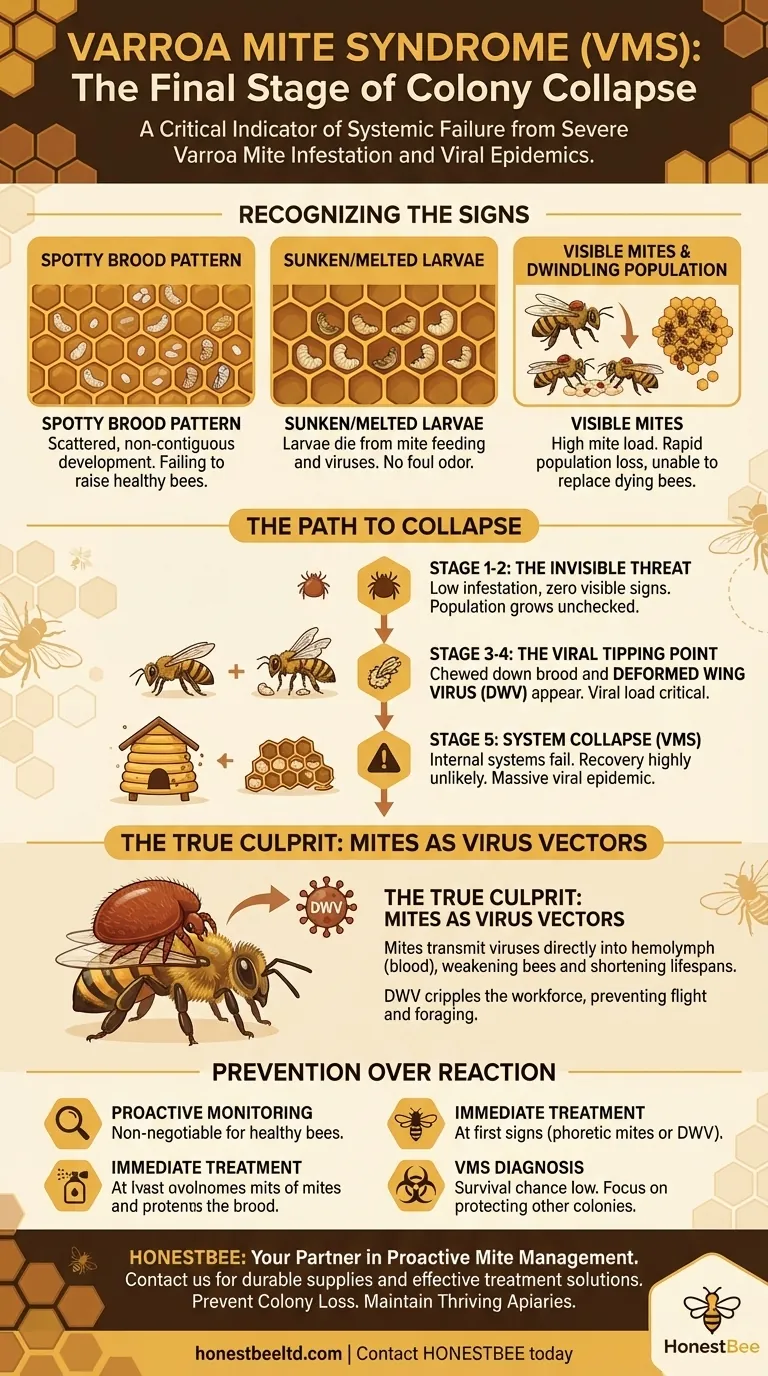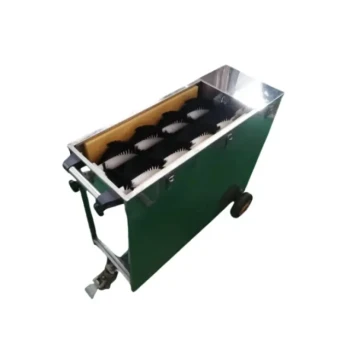In short, Varroa Mite Syndrome (VMS) is the final, visible stage of a honey bee colony collapsing from a severe Varroa mite infestation. It is characterized by a dwindling population, a spotty brood pattern, and sunken or chewed-down larvae. Seeing VMS is a critical indicator that the colony's health has deteriorated past a point of no return due to the overwhelming pressure from both the mites and the viruses they transmit.
The most critical thing to understand is that VMS is not just a mite problem; it is a symptom of a systemic collapse. By the time you see these signs, the colony is suffering from a massive viral epidemic vectored by the mites, making recovery highly unlikely.

Recognizing the Signs of Varroa Mite Syndrome
To properly diagnose VMS, you must learn to recognize a specific cluster of symptoms that, together, paint a grim picture of the colony's health.
The Core Symptoms
The key indicators of VMS include a spotty brood pattern, where eggs, larvae, and pupae are scattered unevenly across the comb instead of being in a solid, contiguous block. You will also see sunken larvae that appear melted or have slid down to the side of their cell. Crucially, this decay occurs without any foul odor, distinguishing it from bacterial infections like American Foulbrood.
The Obvious Culprit
With VMS, Varroa mites are almost always visible. You will see mites on adult bees (phoretic mites), on the brood itself, or crawling on the open brood cells. This high, visible mite load is coupled with a small and rapidly dwindling population, as the colony can no longer raise healthy replacements for its dying bees.
How a Colony Reaches This Critical Stage
A colony does not develop VMS overnight. It is the final stage in a predictable, and preventable, cascade of damage caused by an unchecked Varroa mite population.
Stage 1 & 2: The Invisible Threat
Initially, a low-level mite infestation shows zero visible signs. As the population grows, you may begin to see the first warning signs: phoretic mites riding on the backs of worker bees or drones.
Stage 3 & 4: The Viral Tipping Point
As the mite load increases, you may see signs of Chewed Down Brood, where bees attempt to remove infested pupae. This is quickly followed by the appearance of viruses, most notably Deformed Wing Virus (DWV). Bees born with shriveled, useless wings are a clear sign the viral load in the colony has reached a critical tipping point.
Stage 5: System Collapse (VMS)
This is the final stage where VMS becomes apparent. The combination of parasitic pressure from the mites and the rampant viral infections cripples the colony's ability to function. At this point, the internal systems have failed.
The True Culprit: Mites as Virus Vectors
The most devastating damage from Varroa mites is not the parasite itself, but its role as a vector for deadly viruses.
More Than Just a Parasite
Varroa mites feed on the fat body tissue of honey bees, weakening them and shortening their lifespan. More importantly, as they feed, they transmit and activate viruses directly into the bee's hemolymph (blood).
The Impact of Deformed Wing Virus
High mite populations lead to an epidemic of viruses like DWV. This virus prevents bees from performing essential flight-related tasks, including foraging for the colony. A workforce that cannot fly or forage cannot sustain the colony, leading directly to its deterioration and eventual death.
The Focus Must Be on Prevention, Not Reaction
The goal of any responsible beekeeper is to never see Varroa Mite Syndrome in their hives. Effective management is about controlling mite populations long before they can cause irreversible viral damage.
- If your primary focus is keeping healthy bees: Understand that proactive Varroa mite monitoring and treatment are non-negotiable parts of modern beekeeping.
- If you see early signs (phoretic mites or DWV): You must implement an effective mite treatment plan immediately to prevent the infestation from escalating and causing colony loss.
- If you diagnose Varroa Mite Syndrome: Recognize the colony's chance of survival is extremely low and shift your focus to protecting your other colonies from this hive's high mite load.
Ultimately, diligent and consistent management is the only reliable defense against the devastation of Varroa mites.
Summary Table:
| Symptom | What It Looks Like | What It Indicates |
|---|---|---|
| Spotty Brood Pattern | Uneven, scattered eggs, larvae, and pupae | The colony is failing to raise healthy new bees |
| Sunken/Melted Larvae | Larvae appear decayed, slid to cell sides | Pupae are dying from mite feeding and viral loads |
| Visible Mites | Mites on adult bees and brood cells | A dangerously high, uncontrolled mite population |
| Dwindling Population | Rapidly shrinking number of adult bees | Death rate far exceeds the birth rate of healthy bees |
| Deformed Wing Virus (DWV) | Bees with shriveled, useless wings | A viral epidemic is crippling the workforce |
Protect Your Apiary from Varroa Mite Devastation
Varroa Mite Syndrome is a stark reminder that prevention is the only effective strategy. For commercial apiaries and beekeeping equipment distributors, consistent management with the right tools is essential for survival and profitability.
HONESTBEE supplies the durable, effective beekeeping supplies and equipment you need to implement a robust, proactive mite management plan. From monitoring tools to treatment solutions, we support wholesale-focused operations in safeguarding their most valuable assets.
Contact HONESTBEE today to discuss how our products can help you prevent colony loss and maintain a thriving, productive apiary.
Visual Guide

Related Products
- Adjustable Formic and Acetic Acid Dispenser for Bee Mite Treatment
- Varroa Easy Check Mite Tester Kit Counter Alcohol Wash Jar
- Economy Galvanized Beekeeping Honey Bee Smoker for Wholesale
- Professional Bee Smoker with Elongated Spout and Durable Bellows for Beekeeping
- Wooden Queen Bee Excluder for Beekeeping
People Also Ask
- What are some common predators and pests that target beehives? Protect Your Hives from Bears, Mites, and Beetles
- What are phoretic mites? A Beekeeper's Guide to Monitoring Varroa Infestation
- What does Chewed Down Brood (CDB) indicate in bee colonies? A Sign of Varroa Mite Infestation
- What is the focus of hive management during summer? Maximize Your Honey Harvest with Expert Tips
- How do Varroa mites spread between honey bee colonies? Stop Mite Transmission in Your Apiary



















